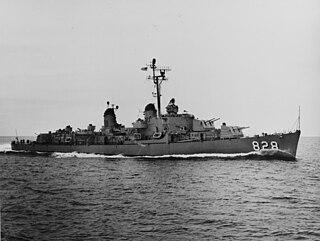Two ships of the United States Navy have borne the name USS Strong, in honor of Rear Admiral James H. Strong (1814–1882), who distinguished himself at the Battle of Mobile Bay.

The United States Navy (USN) is the naval warfare service branch of the United States Armed Forces and one of the seven uniformed services of the United States. It is the largest and most capable navy in the world and it has been estimated that in terms of tonnage of its active battle fleet alone, it is larger than the next 13 navies combined, which includes 11 U.S. allies or partner nations. with the highest combined battle fleet tonnage and the world's largest aircraft carrier fleet, with eleven in service, and two new carriers under construction. With 319,421 personnel on active duty and 99,616 in the Ready Reserve, the Navy is the third largest of the service branches. It has 282 deployable combat vessels and more than 3,700 operational aircraft as of March 2018, making it the second-largest air force in the world, after the United States Air Force.

The Battle of Mobile Bay of August 5, 1864 was an engagement of the American Civil War in which a Union fleet commanded by Rear Admiral David G. Farragut, assisted by a contingent of soldiers, attacked a smaller Confederate fleet led by Admiral Franklin Buchanan and three forts that guarded the entrance to Mobile Bay. A paraphrase of his order, "Damn the torpedoes, full speed ahead!" became famous. Farragut's actual order was "Damn the torpedoes! Four bells. Captain Drayton, go ahead! Jouett, full speed!".
- The first, USS Strong (DD-467), was a Fletcher-class destroyer, launched in 1941 and sunk in action in 1943.
- The second, USS Strong (DD-758), was an Allen M. Sumner-class destroyer, launched in 1944 and struck in 1973.

USS Strong (DD-467), a Fletcher-class destroyer, was the first ship of the United States Navy to be named for Rear Admiral James H. Strong (1814–82), who distinguished himself at the Battle of Mobile Bay.

The Fletcher class was a class of destroyers built by the United States during World War II. The class was designed in 1939, as a result of dissatisfaction with the earlier destroyer leader types of the Porter and Somers classes. Some went on to serve during the Korean War and into the Vietnam War.

In naval terminology, a destroyer is a fast, maneuverable long-endurance warship intended to escort larger vessels in a fleet, convoy or battle group and defend them against smaller powerful short-range attackers. They were originally developed in the late 19th century by Fernando Villaamil for the Spanish Navy as a defense against torpedo boats, and by the time of the Russo-Japanese War in 1904, these "torpedo boat destroyers" (TBDs) were "large, swift, and powerfully armed torpedo boats designed to destroy other torpedo boats". Although the term "destroyer" had been used interchangeably with "TBD" and "torpedo boat destroyer" by navies since 1892, the term "torpedo boat destroyer" had been generally shortened to simply "destroyer" by nearly all navies by the First World War.
| This article includes a list of ships with the same or similar names. If an internal link for a specific ship led you here, you may wish to change the link to point directly to the intended ship article, if one exists. |






